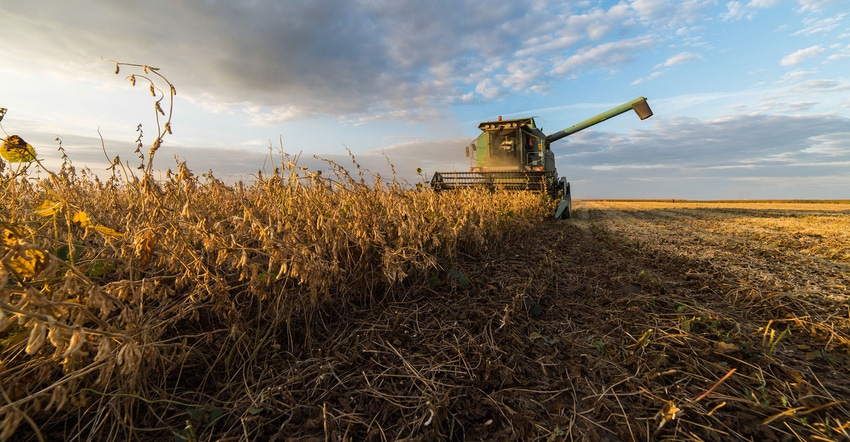
Elizabethtown, Pa., farmer Jim Hershey heard all the bad news about soybeans this fall. Empty pods, rotting pods, diseases and other issues.
So, he was expecting the worst when he recently harvested his 300 acres of soybeans. What he didn’t expect was to average more than 90 bushels per acre with 97 bushels per acre in his smaller contest plot.
"That was quite a shocker I tell you," he says. "You never know when you come through a summer like that what the outcome of the crop is going to be. There was really gloom and doom out there."
There have been widespread reports of corn sprouting, mold and empty pods because of the deluge most farmers experienced from late July through early September.
Hershey says he prefers shorter-season soybeans and got his crop planted before his 200 acres of corn. He says the shorter-season beans performed better than his later-planted varieties, even though he saw more issues with mold in the shorter-season beans.
"It appears that the earlier-planted and shorter varieties may have gotten ahead of the really extreme weather that we had there in August," he says.
But he also attributes his success to cover crops planted last fall.
"I think that could have potentially helped the soil conditions and drainage," he says. "Our fields weren’t standing in a lot of water with all the rain we had. Between July 28 and the end of August we had 30 inches of rain, that’s more than half, three-quarters of the yearly rainfall. It was amazing how resilient the soils were when we went to harvest this fall."
Bob Shearer, owner of Twin Lane Farm in eastern Lancaster County, says his soybeans, planted May 8, averaged more than 80 bushels an acre. Shearer custom combines for other farmers. He says most of the shorter-season beans he saw also performed better.
"Some of them tended to be a little more moldy, but even those, they are good," he says. "I think early planted beans they could capture more sunlight when we had it."
But not all short-season beans performed well. Jeff Graybill, Extension agronomist for Penn State in Lancaster County, says the shorter-season beans he has seen have performed the worst.
"In some cases, individual loads have been rejected, but many guys are being docked anywhere from a few cents to well over $2 a bushel," he says. "Beans planted in late May are generally much better and the double-crop beans are actually pretty nice for most guys. Most folks did have a near normal yield, which helps some."
Graybill says the county’s corn crop matured later, which delayed winter wheat plantings.
"Much of the corn did have moldy tips, but these tended to be very small kernels and seem to be pushed out the back of the combine, so the corn in the bin looks good in most cases," he says. "Yields also are normal. I expect the county average to be around 175 bushels an acre."
Pennsylvania crop progress
The state’s corn is 60% harvested, according to the Nov. 5 Crop Progress Report by the USDA’s National Agricultural Statistics Service. That’s right around the five-year average for this time of year.
Soybeans are 55% harvested, behind the 77% five-year average. Winter wheat is 90% planted, right around the state’s five-year average.
On track in Maryland
In Maryland, 91% of corn has been harvested, slightly ahead of the 87% average. Soybeans are 59% harvested, which is right around average, and winter wheat plantings are 75% complete, also around average for this time of year.
Delaware’s corn crop is 96% complete. Soybeans are 24% complete, behind the 48% average. Farmers have planted 89% of the winter wheat crop, well ahead of the 66% average.
Struggles in New Jersey
Bill Sciarappa, Rutgers Extension agriculture agent, says farmers struggled with erratic weather that delayed plantings and reduced yields.
Heavy rains later in the season diluted fertilizer and herbicides, leading to slow growth of field corn, sweet corn and specialty vegetables.
"In monitoring six corn-soybean rotations, the growers thought this was one of the worse seasons as temperatures went from 45 to 100 degrees to stress crops and people, with humidity leading to very high misery indices," he wrote in an email. "This was the second hottest season in recorded New Jersey history by one-tenth of a degree. Southern storms brought up resistant moths that have damaged crops as well, and rain and muddy fields prevented timely insecticide and fungicide applications."
Only 45% of grain corn has been harvested, well behind the 72% average. Soybeans are also behind with 32% of the crop harvested, behind the 54% average.
Winter wheat is 71% planted.
Empire crop progress
In New York state, 40% of corn has been harvested, right around the five-year average. Soybeans are a little behind with 52% harvested, behind the 71% average.
Winter wheat is 77% in the ground, behind last year’s pace of 96%.
Apples are a little ahead with 96% of the crop harvested; 92% is the five-year average. Grapes are 98% harvested, ahead of the 89% average.
About the Author(s)
You May Also Like






